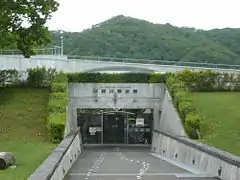Historical Museum of the Saru River
The Historical Museum of the Saru River (沙流川歴史館, Saru-gawa Rekishi-kan) opened in the Nibutani area of Biratori, Hokkaidō, Japan in 1998, the year after Nibutani Dam was completed.[1] The Museum documents the natural and cultural history of life along the Saru River and has information on nearby chashi. The collection includes 123 objects dating from the fifteenth to the seventeenth centuries that were excavated from the Nibutani Site (二風谷遺跡) and have been designated a Prefectural Cultural Property.[2] The "Cultural Landscape along the Sarugawa River resulting from Ainu Tradition and Modern Settlement" has been designated an Important Cultural Landscape.[3][4]
| Historical Museum of the Saru River | |
|---|---|
沙流川歴史館 | |
 | |

| |
| General information | |
| Address | 227-2 Nibutani |
| Town or city | Biratori, Hokkaidō |
| Country | Japan |
| Coordinates | 42°38′14″N 142°09′21″E |
| Opened | 1998 |
| Website | |
| Official website | |
See also
- Nibutani Ainu Culture Museum
- Cultural Landscapes of Japan
- List of Historic Sites of Japan (Hokkaidō)
- Hokkaido Museum
- Ainu culture
References
- 二風谷ダムをとりまく経緯 [Chronology of Nibutani Dam] (PDF) (in Japanese). Ministry of Land, Infrastructure, Transport and Tourism. Retrieved 30 October 2016.
- 二風谷遺跡群出土品 [Items Excavated from Nibutani Site] (in Japanese). Agency for Cultural Affairs. Retrieved 30 October 2016.
- 重要文化的景観紹介 [Introduction to the Important Cultural Landscape] (in Japanese). Nibutani Ainu Culture Museum. Retrieved 30 October 2016.
- アイヌの伝統と近代開拓による沙流川流域の文化的景観 [Cultural Landscape along the Sarugawa River resulting from Ainu Tradition and Modern Settlement] (in Japanese). Agency for Cultural Affairs. Retrieved 30 October 2016.
This article is issued from Wikipedia. The text is licensed under Creative Commons - Attribution - Sharealike. Additional terms may apply for the media files.
